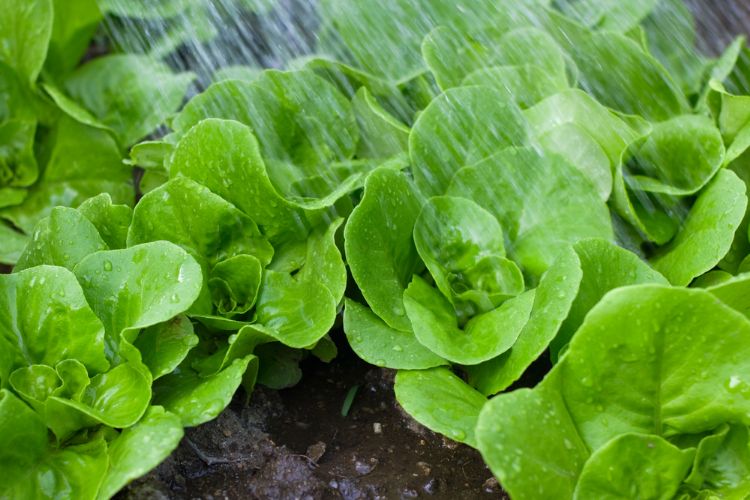If you’re new to container gardening, or just looking to grow your own lettuce so you can stop buying it from the store, these tips will help make sure your growing project is successful!
Lettuce is one of the easiest veggies to grow in containers, and the results of your efforts are seen fairly quickly. With these tips, you can be enjoying the bounty of your own harvest in a short six to eight weeks after planting.
Advertisement
1. Pot selection
Lettuce has a fairly short root system, and plants don’t grow that tall (6-12” at most) so your planting containers don’t need to be very deep. The best containers are shallow and wide.
Lettuce has a fairly short root system, and plants don’t grow that tall (6-12” at most) so your planting containers don’t need to be very deep. The best containers are shallow and wide.

Shutterstock
2. Drainage
After choosing containers to use, make sure the bottom has plenty of drainage holes to allow excess water to run out. If you have plastic containers use either an electric drill or a hammer and nail to put holes in the bottom.
After choosing containers to use, make sure the bottom has plenty of drainage holes to allow excess water to run out. If you have plastic containers use either an electric drill or a hammer and nail to put holes in the bottom.

Shutterstock
3. Soil
Fill growing containers with a premixed potting soil that has plenty of organic matter. Professional potting soil will hold moisture better than garden soil, supplying a more continuous source of water to plants.
Fill growing containers with a premixed potting soil that has plenty of organic matter. Professional potting soil will hold moisture better than garden soil, supplying a more continuous source of water to plants.

Shutterstock
4. Lettuce types
To maximize the smaller space when container gardening, look for “cut and come again” lettuce varieties. Planting these types will encourage repeat harvests and a steady supply of lettuce.
To maximize the smaller space when container gardening, look for “cut and come again” lettuce varieties. Planting these types will encourage repeat harvests and a steady supply of lettuce.

Shutterstock
5. Planting
Lettuce can easily be grown by directly sowing seeds, or by planting seedlings. It is also possible to start romaine lettuce from kitchen scraps, after you remove all of the leaves from the stem.
Lettuce can easily be grown by directly sowing seeds, or by planting seedlings. It is also possible to start romaine lettuce from kitchen scraps, after you remove all of the leaves from the stem.

Shutterstock
6. Spacing
Since you will be harvesting lettuce fairly often, plant spacing isn’t as huge of a concern as it is in other vegetables. But plants will grow best if thinned to 4-6” apart.
Since you will be harvesting lettuce fairly often, plant spacing isn’t as huge of a concern as it is in other vegetables. But plants will grow best if thinned to 4-6” apart.

Shutterstock
7. Light
Lettuce loves sunlight, but needs to be protected by the intense heat of the day. To keep lettuce from drying out, create shade for plants in the hot afternoon sun or move containers out of the direct light to a shadier location.
Lettuce loves sunlight, but needs to be protected by the intense heat of the day. To keep lettuce from drying out, create shade for plants in the hot afternoon sun or move containers out of the direct light to a shadier location.

Shutterstock
8. Water
Being almost 95% water, lettuce needs plenty of moisture to grow. Shallow containers and/or short root systems need frequent watering to keep lettuce from drying out. Aim to keep the soil slightly moist at all times.
Being almost 95% water, lettuce needs plenty of moisture to grow. Shallow containers and/or short root systems need frequent watering to keep lettuce from drying out. Aim to keep the soil slightly moist at all times.

Shutterstock
9. Fertilizer
One or two small applications of fertilizer are typically adequate for lettuces, since they have such a quick growing season. Allow seedlings to establish for a couple of weeks after planting before applying fertilizer.
One or two small applications of fertilizer are typically adequate for lettuces, since they have such a quick growing season. Allow seedlings to establish for a couple of weeks after planting before applying fertilizer.

Shutterstock
10. Bolting
Lettuce plants will shoot up spikes and try to go to seed (i.e. "bolt") when daytime temperatures get too high. Keep plants shaded in the heat of the day, and well watered, to help prevent bolting since it is irreversible.
Lettuce plants will shoot up spikes and try to go to seed (i.e. "bolt") when daytime temperatures get too high. Keep plants shaded in the heat of the day, and well watered, to help prevent bolting since it is irreversible.
11. Pests
Container gardening usually means less insect pests but watch for leaf eating insects such as aphids. Apply a spray of horticultural soap immediately if pests are spotted.
Container gardening usually means less insect pests but watch for leaf eating insects such as aphids. Apply a spray of horticultural soap immediately if pests are spotted.
12. Harvesting
Gently cut the outside leaves of leaf lettuce when plants are young and tender (approximately 4-6” tall). If plants you wait to long to harvest, plants will begin to bolt and the leaves will become bitter.
Gently cut the outside leaves of leaf lettuce when plants are young and tender (approximately 4-6” tall). If plants you wait to long to harvest, plants will begin to bolt and the leaves will become bitter.

Shutterstock
Advertisement
Fresh from the garden veggies are hard to beat. Thankfully, lettuce can be easily grown in containers and requires little care compared to most vegetables. So, take the leap and try your hand at it!

